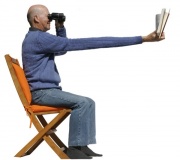Contents |
Contact Lenses in Presbyopia: Monovision
Introduction
Presbyopia is a common condition that begins at about age 40 that makes vision at near blurry. Most adults begin to experience difficulty with reading at that time, and this is a part of the aging process, but not in the way most people might think.
(For this discussion and article, the term "near" or "nearpoint" means that the book or computer monitor is about 16 to 18 inches (40 to 45 cm) away from the eyes. In a similar way, “distance” or “far” vision is at least 20 feet away. In practical terms, looking across a room at a calendar or a television screen qualifies as far; reading, sewing and tying fishing flies are all activities that require good near vision.)
If you wear contact lenses, it is a safe assumption that you need corrective eyewear for distance. Most of the time, your glasses or contacts provide a full correction so your distance vision is clear without any additional effort of the internal muscles that automatically add or subtract power as you change from far to near and back again.
The focusing system, sometimes called accommodation, works very well for most of us when we are young and through our twenties and thirties, but even then changes were taking place in the eye that we won’t usually notice until that magic age of forty. (When your "arms are too short" to read clearly, above.)
The eye changes focus from distance to near and back again by contracting and relaxing muscles that are part of the iris. The crystalline lens, located behind the iris, changes shape in response to these muscles, getting fatter and thinner, depending on how far away or how close the object we are looking at is.
But the lens is one of the only tissues in the body that continues to grow as we get older, and in a similar way to the rings in a growing tree do, the lens acquires new layers over time. This has the effect of making the lens thicker and stiffer, and therefore making it less responsive to our efforts to focus. (All of this effort is mostly automatic, like breathing; we don’t have to think about doing it, the vision system just takes care of it. In fact, we can't really tell if we actually are trying harder to focus, at least not until we are unable to do it adequately and our near vision becomes blurry.)
Usually at about age forty, the lens reaches a point where it just isn’t flexible enough to make near vision clear. When we reach this stage, we are said to by presbyopic. Even when we need to use artificial means (multifocal spectacles), the lens inside the eye still continues to change, until we develop cataracts and undergo cataract extraction surgery. That is why, when we first begin to need reading glasses, the power necessary is less than it will be at the age of sixty or so. Each year, the lens gets a little thicker, and we need a little more help focusing.
Presbyopia itself, however, does not usually affect the prescription lenses needed for distance.
Good news and Bad News
The bad news for contact lens wearers is that your regular, single-power contact lenses will no longer suffice; you need one prescription lens power for your distance vision, and another for near. (That’s what “multifocal” means: more than one focal length in the same lens.)The good news is that there are several different options to consider if you want to continue wearing your contact lenses once you reach presbyopia. They include using reading glasses over your contact lenses when you need to see something up close; getting prescription eyeglasses in either single vision or multifocals, also for use with your contacts; or switching to one of several types of multifocal contact lenses, which are more complex to fit and thus more expensive (but which are very satisfactory for many.
Depending on your individual needs and the visual demands of your work and leisure time, any one of these choices may be just what you need and will work very well, however… there is yet another, that of monovision.
Did you know that most people have a dominant eye, in the same way we have a dominant hand? Monovision takes advantage of this fact to allow the use of the same type and style of single-vision contact lenses that you had previously, until you became presbyopic
Once the dominant eye is determined (one quick way is to ask yourself which eye you would use to take a photograph), the prescription power is usually the one needed for good distance vision, while the other eye will use one that is appropriate for good near vision.
Advantages and Disadvantages
A monovision fitting strategy for presbyopia is extremely successful for many people, especially those who have never used reading glasses or multifocal eyeglasses. After adaptation and some practice, most patients who try monovision find that they are able to shift their vision almost automatically between their distance eye and their near one.
Advantages of monovision for presbyopic contact lens wearers include:
- No changes in wearing schedule are required
- No changes to cleaning and disinfecting routines are required
- No re-adaptation to a different lens style is needed
- Rigid gas-permeable, hybrid, silicone hydrogels and soft lenses are all perfectly acceptable
- No changes in price for lenses
For some people, a major disadvantage is the change in their depth perception, but this may not be as much of a problem as some would think. Driving is the activity most mentioned in connection with this, but a case can be made for the type of depth perception needed at distance being different from actual stereo-optical vision. In driving, we use what are called monocular cues, which are things such as the fact that things that are closer to us are larger, that they overlap more distant objects, and that perspective changes with distance. We also get quite a lot of depth and distance information from our peripheral vision. There are many safe drivers on the roads that have the use of only one eye for one reason or another, but someone new to monovision should, of course, use extra caution while driving, especially until there has been sufficient adaptation.
People who drive for a living or who operate heavy machinery may need a third contact lens that corrects their distance vision for their near eye, or a spectacle prescription with correction for the reading eye to improve binocular vision. Similarly, some wearers may require an additional near vision correction to use for the distance eye to allow prolonged or concentrated reading.
In another twist, there is a variation of monovision called modified monovision, which puts a multifocal contact lens in one eye and a single-vision lens in the other. This can give better depth perception while still permitting near vision for reading.
An aside here for those who may be considering refractive surgery (usually LASIK) in the form of permanent monovision may want to try it first with contact lenses for a few months to be sure they are among those who would be successful with it. (Also please see our article about the Kamra Inlay.)
The Bottom Line
Monovision is not for everyone, of course, but many people have tried it and do very well with this modality. It works very well for people with active lifestyles, who don’t want to wear eyeglasses most of the time.
It is perhaps helpful to know that people almost select themselves into or out of monovision; chances are that if you have read this far and find yourself intrigued by its possibilities, you have probably already decided to try it. In the same way, if you feel unsure or find yourself thinking that you don’t feel comfortable with it, you may already have rejected this option. What some people would term a mild mismatch between the images from their two eyes, others will perceive as being impossible to tolerate.
No solution for presbyopia is right for everyone, any more than the same eyeglass frames work on every face. Ask your optometric physician for help in deciding what options may work for you and match your activities and lifestyle.







